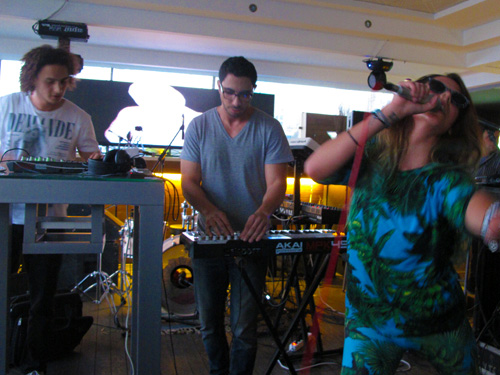When I go to electronic music concerts in Egypt, I like to play a little joke. I ask strangers, “Is electronic music an Egyptian art form?” The answer is predictable. Most people, even fans of the genre, are unaware that electronic music and experimental sound art have a history in Egypt. It is largely thought of as an imported, Western art form.
But electronic music has deep roots in Egypt going back to the early 20th century, when radical young composers experimented with sound, instruments, and new machines. One such composer, the Egyptian musician and ethnomusicologist, Halim al-Dabh, worked with well-known experimental musicians John Cage and Henry Cowell, among others, eventually becoming a vital part of the New York electronic music and sound scene.
Al-Dabh was born in Cairo in 1921, after the family moved to the Egyptian capital from Assiut, in Upper Egypt. He graduated from Cairo University and went to the United States on a Fulbright Scholarship to explore both archaic and new sounds. Al-Dabh is now Professor Emeritus of African Ethnomusicology at Kent State University, in Ohio, where he continues to teach African Cultural Expressions.
Al-Dabh continued his research in several African countries, from Egypt to South Africa, through North Africa and the continent’s west and east coasts, later travelling to Brazil and Jamaica. He focused on pentatonic scales (five pitches per octave), minimalism, and repetition–qualities common in Egyptian traditions such as the Coptic Mass and Zaar. His compositions for the orchestra and for solo instruments are performed worldwide. He famously composed four dance performance scores for leading American choreographer Martha Graham, and his celebrated percussion works include “Symphony for 1000 Drums.”
Al-Dabh’s early experiments with electronic music, in which he manipulated sound through wire recorders in Cairo, are considered a landmark in the brief history of the genre. Eventually he collaborated with other musicians and conducted several electronic music groups and centers in the United States. Laila and the Poet, his 1960s electronic music drama, is now considered an important composition in world electronic music. And yet, in Egypt, his name is largely unknown.
A couple of years ago in Assiut, at an electronic music concert organized by 100 Copies–an Egyptian initiative that supports electronic and experimental music in Egypt–I resumed my questioning of the audience about this “westernized” art form. In spite of the fact that they were gathered in appreciation of what was essentially his musical legacy, no one had heard of Halim al-Dabh.
How had it happened that an internationally celebrated artist is not remembered in his home? What about contemporary Egypt makes it possible to forget the country’s great pioneers? And, why do we find it hard to believe that a radical genre such as electronic music could have an Egyptian founding father?
Egypt has one of the strongest music industries in the region, boasting the first and oldest opera house, and one of the main Egyptian exports is song. In fact, it was Umm Kolthoum and Laila Murad who introduced the world to the Egyptian dialect. It would be difficult to find an Egyptian unfamiliar with these two singers. But is the present too opaque to see through a larger history of music talent in the country that includes people like al-Dabh.
Nevertheless, some efforts are being made to secure al-Dabh's legacy. In 2002, the Bibliotheca Alexandrina invited him to a release celebration of his compositions on CD, part of a long-term project to re-launch historical compositions by leading Egyptian composers.
And, although most Egyptians do not recognize his name, they have probably heard his music, as have the country’s numerous tourists, who flock to witness a quintessentially Egyptian blending of the ancient and the new: the popular, Sound & Light Show at the Pyramids, which is choreographed to one of el-Dabh’s compositions.




